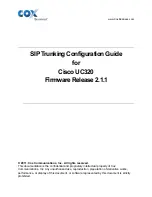
Property of Cox Communications, Inc.
Version 1.0
Page
4 of 13
3 SIP Trunking Network Components
The network for the SIP trunk reference configuration is illustrated below and is representative of a Cisco
UC320 network configuration.
Cox E-SBC
Static LAN IP: 192.168.1.1
Net Mask: 255.255.255.0
Cox
IP Network
PSTN
SIP Call Server
Customer Premise
Cox
Acme Packet
Net-Net 9200
Session Border
Controller (SBC)
Voice VLAN DHCP IP: 10.1.1.2
DID: 678-236-7401
Voice VLAN DHCP IP: 10.1.1.3
DID: 678-236-7402
Voice VLAN DHCP IP: 10.1.1.4
DID: 678-236-7403
Cisco UC320 PBX
DHCP Server for Voice VLAN
Static WAN IP: 192.168.1.2
Voice VLAN IP: 10.1.1.1
Data VLAN Static IP: 192.168.10.2
Trunk Group Pilot #: 678-236-7400
Analog Fax
FXS
Pre-Existing Router
DHCP Server for Data VLAN
(Default Gateway)
Data VLAN IP: 192.168.10.1
Cox
Internet
Data VLAN DHCP IP:
192.168.10.x
Data VLAN
Figure 2 - SIP Trunk Lab Reference Network
The lab network consists of the following components:
Cisco UC320 PBX for voice features, SIP proxy and SIP trunk termination. In this configuration,
the UC320 only routes voice traffic.
Various SIP phones on the voice Virtual LAN (VLAN).
The Cox E-SBC is the Edgewater Networks (
www.edgewaternetworks.com
) EdgeMarc appliance.
The EdgeMarc is the service demarcation point between customer’s LAN network and Cox’s
WAN network and provides firewall/NAT traversal, B2BUA and SIP Application-level gateway.
The EdgeMarc has diverse routes to a primary and secondary Acme SBC.
A router for the data VLAN and Internet access.
Acme Packet Net-Net 9200 Session Border Controllers (SBC).
The Cisco UC320 configuration detailed in this document is based on a lab environment with a simple
dial-plan used to ensure proper interoperability between COX SIP network and Cisco UC320 telephony
solution. The configuration described in this document details the important commands to have enabled
for interoperability to be successful. Necessary precaution must be taken, by the network administrator
who is deploying the Cisco UC320 with E-SBC in a production environment, to ensure these commands
are followed for proper interoperability to COX SIP network.














